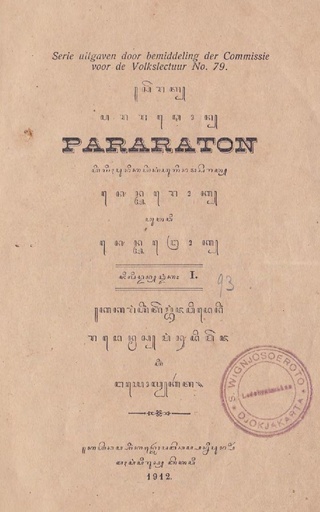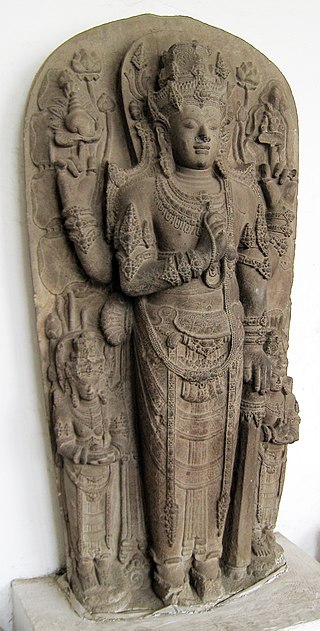
Majapahit, also known as Wilwatikta, was a Javanese Hindu-Buddhist thalassocratic empire in Southeast Asia that was based on the island of Java. It existed from 1293 to circa 1527 and reached its peak during the era of Hayam Wuruk, whose reign from 1350 to 1389 was marked by conquests that extended throughout Southeast Asia. His achievement is also credited to his prime minister, Gajah Mada. According to the Nagarakretagama written in 1365, Majapahit was an empire of 98 tributaries, stretching from Sumatra to New Guinea; consisting of present-day Indonesia, Singapore, Malaysia, Brunei, southern Thailand, Timor Leste, southwestern Philippines although the scope of Majapahit sphere of influence is still the subject of debate among historians. The nature of Majapahit's relations and influence upon its overseas vassals and also its status as an empire still provokes discussion.

The kris or keris is a Javanese asymmetrical dagger with a distinctive blade-patterning achieved through alternating laminations of iron and nickelous iron (pamor). The kris is famous for its distinctive wavy blade, although many have straight blades as well, and is one of the weapons commonly used in the pencak silat martial art native to Indonesia. Kris have been produced in many regions of Indonesia for centuries, but nowhere—although the island of Bali comes close—is the kris so embedded in a mutually-connected whole of ritual prescriptions and acts, ceremonies, mythical backgrounds and epic poetry as in Central Java. Within Indonesia the kris is commonly associated with Javanese culture, although other ethnicities in it and surrounding regions are familiar with the weapon as part of their cultures, such as the Balinese, Sundanese, Malay, Madurese, Banjar, Buginese, and Makassar people. The kris itself is considered as a cultural symbol of Indonesia and also neighbouring countries like Brunei, Malaysia, Philippines, Singapore, and Thailand.

Singhasari, also known as Tumapel, was a Javanese Hindu-Buddhist kingdom located in east Java between 1222 and 1292. The kingdom succeeded the Kingdom of Kediri as the dominant kingdom in eastern Java. The kingdom's name is cognate to the Singosari district of Malang Regency, located several kilometres north of Malang City.

Malang, historically known as Tumapel, is an inland city in the Indonesian province of East Java. It has a history dating back to the age of the Singhasari Kingdom. It is the second most populous city in the province, with a population of 820,043 at the 2010 Census and 843,810 at the 2020 Census; the official estimate as of mid-2023 was 847,182. The Malang Metropolitan area was home to 3,663,691 inhabitants in 2010, spread across two cities and 22 districts. Malang is the third largest city by economy in East Java, after Surabaya and Kediri, with an estimated 2016 GDP at Rp. 44.30 trillion.
Anusapati, Anushanatha, or Anushapati, is the second king of Singhasari, an Indianized Hindu kingdom located in east Java between 1222 and 1248.

Ken Dedes was the first concubine of Singhasari. She was the concubine of Ken Arok,while Ken Rimang is the Empress. the first ruler of Singhasari, Java, Indonesia. She was later considered the origin of the lineage of kings that ruled Java, the great mother of the Rajasa dynasty, the royal family that ruled Java from the Singhasari to the Majapahit era. Local tradition mentioned her as an embodiment of perfect beauty.

Kediri Kingdom was a Hindu-Buddhist Javanese kingdom based in East Java from 1042 until 1222. This kingdom is centered in the ancient city Dahanapura, despite the lack of archaeological remains, the age of Kediri saw much development in classical literature. Mpu Sedah's Kakawin Bharatayuddha, Mpu Panuluh's Gatotkacasraya, and Mpu Dharmaja's Smaradhana blossomed in this era. The kingdom's capital is believed to have been established in the western part of the Brantas River valley, somewhere near modern Kediri city and surrounding Kediri Regency.
Ken Arok, Rajasa, was the founder and first ruler of Singhasari, a medieval Indianized Hindu–Buddhist kingdom in the East Java area of Indonesia. He is considered the founder of the Rajasa dynasty of the Singhasari and Majapahit line of monarchs. He came from humble origins but subsequently rose to be the most powerful ruler in Java. His life was coloured with adventures, treacheries, and tragedies.

The Pararaton, also known as the Katuturanira Ken Angrok, is a 16th-century Javanese historical chronicle written in Kawi. The comparatively short text of 32 folio-size pages contains the history of the kings of Singhasari and Majapahit in eastern Java.

Raden Wijaya or Raden Vijaya was a Javanese emperor, and the founder and first monarch of the Majapahit Empire. The history of his founding of Majapahit was written in several records, including Pararaton and Negarakertagama. His rule was marked by the victory against the army and the Mongol navy of Kublai Khan's Yuan dynasty.

The Kingdom of Janggala is one of the two Javanese kingdoms that was formed when Airlangga abdicated his throne in favour of his two sons in 1045. The other Kingdom was Kediri. The Kingdom of Janggala comprised the northeastern part of the Kingdom of Kahuripan.

Sri Maharajadiraja Sri Kertanegara Wikrama Dharmatunggadewa, Kritanagara, or Sivabuddha, was the last and most important ruler of the Singhasari kingdom of Java, reigning from 1268 to 1292. Under his rule Javanese trade and power developed considerably, reaching the far corners of the Indonesian archipelago.

Malang Regency is the second largest regency in East Java, Indonesia, with a total area of 3,530.65 km (2,193.84 mi). It is rich in potential for agriculture, medicinal plants and tourism.

The Demak Sultanate was a Javanese Muslim state located on Java's north coast in Indonesia, at the site of the present-day city of Demak. A port fief to the Hindu-Buddhist Majapahit kingdom thought to have been founded in the last quarter of the 15th century, it was influenced by Islam brought by Muslim traders from China, Gujarat, Arabia and also Islamic kingdoms in the region, such as Samudra Pasai, Malacca and Bani (Muslim) Champa. The sultanate was the first Muslim state in Java, and once dominated most of the northern coast of Java and southern Sumatra.

Tribhuwana Wijayatunggadewi, known in her regnal name Tribhuwannottunggadewi Jayawishnuwardhani, also known as Dyah Gitarja or Gitarja, was a Javanese queen regnant and the third Majapahit monarch, reigning from 1328 to 1350. She also bears the title Bhre Kahuripan. With the help of her prime minister Gajah Mada, she pursued a massive expansion of the empire. Tradition mentioned her as a woman of extraordinary valour, wisdom and intelligence.

Penataran or Panataran is one of the largest Hindu temple ruins complexes in East Java, Indonesia. It is located in Penataran, Blitar Regency, roughly 12 km northeast of Blitar, with the closest airport being farther away at Malang. Believed to have been constructed between the 12th century to the 15th century, the temple played a significant role in the Majapahit Kingdom, especially under King Hayam Wuruk. He considered it his favorite sanctuary. Penataran dates from the Kediri era.
The Rajasa dynasty was the ruling dynasty of Singhasari and later Majapahit during the 13th to 15th centuries in eastern Java. The rulers of the Rajasa dynasty trace their origins back to Śrī Ranggah Rājasa, who founded the dynasty in the early 13th century. According to Pararaton, Ranggah Rājasa was born in the town of Tumapel. He was considered as the founder of both the Singhasari and Majapahit line of monarchs.
Jayakatwang was the king of short-lived second Kingdom of Kediri of Java, after his overthrow of Kertanegara, the last king of Singhasari. He was eventually defeated by Raden Wijaya, Kertanegara's son-in-law using the troops of the Mongol Yuan dynasty that were invading Java. Raden Wijaya would later turn against the Mongols and found Majapahit, a great empire centered around Java.
Pasisir is the name given to the northern coastal region of Java. Unlike the agricultural kingdoms of the hinterland, the pasisiran economy has been based on trade via the Java Sea and its cultural identity has been shaped by foreign contacts and the presence of Arab Indonesians and Chinese Indonesians.
Kertajaya or Kritajaya also called Dandhang Gendhis was the last king of the Kediri Kingdom who ruled around 1194–1222. At the end of his reign he declared that he wanted to be worshiped as a god. Kertajaya was killed by Ken Arok from Tumapel or Singhasari, which ended the period of the Kediri Kingdom.













